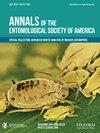Basis for the Management of Schistocerca cancellata (Orthoptera: Acrididae)
IF 1.8
3区 农林科学
Q1 ENTOMOLOGY
引用次数: 1
Abstract
Abstract The locust species Schistocerca cancellata Serville, endemic to South America, is known for its ability to form dense swarms, which reach the status of agricultural pest for several crops in southern South America.This article aimed to gather more accurate information about the history, biology, ecology, and control of S. cancellata, because of the 2021 invasions, which threatened to invade the Brazilian territory. During outbreak periods, swarms consume any available vegetation in the occurrence areas of Argentina, Brazil, Paraguay, Uruguay, Chile, and Bolivia.These invasions have been well documented in history, since they left deep marks wherever they went, especially in Argentina, which to this day represents the country that most accounted for agricultural losses from outbreaks. economy's main current means of control are based on pesticides, whose chemical composition induces a series of damages to health, the environment, and consequently the ecosystem. Knowing about the biological processes of this locust is an important factor in understanding how swarms form, as well as controlling them. The intergovernmental coalition shows positive results in monitoring and controlling the swarms, which, even demonstrating stability, remain under constant surveillance by competent bodies.取消血吸虫管理基础(直翅目:蝗科)
摘要:南美洲特有的松质蝗虫Schistocerca cancellata Serville以其形成密集蝗虫群的能力而闻名,这种蝗虫群在南美洲南部的几种作物中达到了农业害虫的地位。由于2021年的入侵,本文旨在收集关于松质蝗虫的历史、生物学、生态学和控制的更准确信息,它威胁要入侵巴西领土。在疫情爆发期间,蝗虫群会吞噬阿根廷、巴西、巴拉圭、乌拉圭、智利和玻利维亚等地的任何可用植被。这些入侵在历史上都有很好的记录,因为它们所到之处都留下了深刻的印记,尤其是在阿根廷,直到今天,阿根廷是疫情造成农业损失最多的国家。目前经济的主要控制手段是基于杀虫剂,其化学成分会对健康、环境以及生态系统造成一系列损害。了解蝗虫的生物学过程是了解蝗虫群如何形成以及控制蝗虫群的重要因素。政府间联盟在监测和控制蝗虫群方面取得了积极成果,尽管表现出稳定,但仍受到主管机构的持续监测。
本文章由计算机程序翻译,如有差异,请以英文原文为准。
求助全文
约1分钟内获得全文
求助全文
来源期刊
CiteScore
4.90
自引率
0.00%
发文量
25
审稿时长
6-12 weeks
期刊介绍:
The Annals of the Entomological Society of America exists to stimulate interdisciplinary dialogue across the entomological disciplines and to advance cooperative interaction among diverse groups of entomologists. It seeks to attract and publish cutting-edge research, reviews, collections of articles on a common topic of broad interest, and discussion of topics with national or international importance. We especially welcome articles covering developing areas of research, controversial issues or debate, and topics of importance to society. Manuscripts that are primarily reports of new species, methodology, pest management, or the biology of single species generally will be referred to other journals of the ESA. The most important criteria for acceptance are quality of work and breadth of interest to the readership.

 求助内容:
求助内容: 应助结果提醒方式:
应助结果提醒方式:


